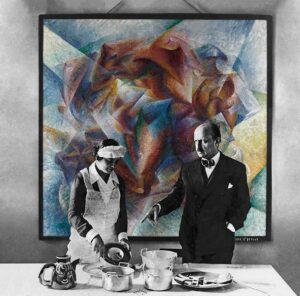The title of this massive exhibition at the Fondazione Prada in Milan refers to Tommaso Marinetti’s visual poem, founder of the Futurist movement in the 20s. However, it would not be correct to define it only as an exhibition on futurism because it is much more complex; it took over two years for the curator, Germano Celant, to prepare the exhibition. It is a historical reconstruction of the complex relationships between the reigning political and economic power and the artists of that time.
Starting from the assumption that art does not exist in the abstract but is formed in a given historical context, the works (more than 600, including paintings, sculptures, drawings, photographs, posters, furnishings, projects and architectural models, made by over 100 authors) are presented in the environment in which they were exhibited: artists’ studios, private collections, major Biennial, Triennial, Quadrennial Fascist regime exhibitions, or art galleries, these historical photos found in archives, museums, libraries, and the partial reconstruction of the original exhibition spaces, bear witness to this past.

The aim, says the curator, is to contrast the simple viewing of the works exhibited in the white and anonymous spaces of the galleries and museums and to present them in their historical communication context. The years between 1918 and 1943 are marked in Italy by the crisis of the liberal state, by the advent of Fascism and its fall, by a world war. The artists, in large part, adhere to the Fascist regime, some passively, others with total conviction; few oppose the dictatorship and suffer imprisonment and confinement. The end of Nazi-fascism reveals the true face of the war and its atrocities.
In the darkest years of Italian history, despite the rigidity and conformism of the regime, movements that animate the artistic scene are born, such as Futurism, Novecento, the so-called Scuola romana, the Abstractionists and Corrente, among the most important, in which the avant-garde and return to order, experimentation and realism, intimism and propaganda coexist.
On display visitors can admire masterpieces by Boccioni, Balla, Depero, Casorati, Sironi, Morandi, De Chirico, sculptures by Martini and Wildt, models of the rationalist architecture of Portaluppi, Terragni and the visionary projects of Sant’Elia. From the futuristic exaltation of the values of speed, of the revolution and of the armed conflict, decades later we are able to condemn the war and the massacres it generated.
Two exemplary works are “Dynamism of a Soccer Player” by Umberto Boccioni (1913), and “Crucifixion” by Renato Guttuso (1941). Not even thirty years have passed but the world has changed.
The first painting is the work of one of the masters of Futurism, one of the most remarkable examples of his style, plastic dynamism. The artist does not only model the body of the athlete, but also the environment around him (the air, the light, the ground …), which the player crosses in his movement in an explosion of energy. Strength, challenge and youth are among the leitmotifs of the Futurist movement.
In the work of Guttuso there are other dominant values: human suffering is expressed not only by the crucified Christ, but also by the sorrowful humanity that surrounds it. The work caused a scandal due to the nudes of Mary Magdalene and the Roman soldiers, depicted on horseback as a reference to Picasso’s “Guernica”. The painter pointed out that nudity represented the timelessness of his work, which referred to all the “crucifixions” caused by wars. The vitality and adherence of Futurism to the war have disappeared in front of a reality of mourning and suffering.
From the proclamations of Post Zang Tumb Tuuum to the silence of pain.
Liviana Martin, Italian Editor
POST ZANG TUMB TUUUM . Art life politics: Italy 1918- 1943 18 February – 25 June 2018
Volume 33.no.1 September / October 2018 p 24

Hi Liviana,
I really enjoyed your review on the futurists exhibition. Do you know of a website where I can find Tommaso Marinetti’s visual poem, Post Zang Tumb Tuuum? I would very much like to read it, or even better, hear it with an Italian reader.
Thank you,
Thomas
Hi Thomas
I found it on You Tube typing “Post Zang Tumb
Liviana